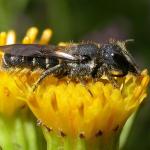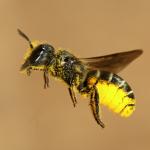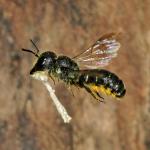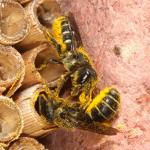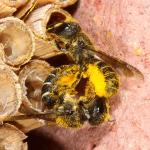Apis xanthogastria SCHRANK 1802; Osmia punctatissima LEPELETIER 1841; Heriades mordax SCHLETTERER 1889
A small elongate bee with distinctive terminal white hair bands on the abdomen; the female with an orange scopa. This species has always been considered scarce and associated with the commons of Surrey. It utilises resin in the making of the partitions of its nest and the assumption that this could only be provided by pines, combined with its apparent restriction to heaths, suggested to some that it must be an introduction to Britain. I was therefore pleasantly surprised when G R Else and I found a large population based at Thorney Island, with not a pine in sight! Not only this, but this population also had the specialist cleptoparasite Stelis breviuscula present. This latter bee had only been recently discovered in Britain at Iping Common by G R Else a year or two earlier. This story reveals the perils of believing that everything is already known about any particular species – West Sussex had been hardly visited by aculeate hymenopterists in the hundred years previous to G R Else and me taking an interest in the western section of the county.
Known from south-eastern England. This species is undoubtedly spreading and becoming more frequently found, probably in response to the warmer late summers of the past twenty years. The record for Oxfordshire suggests it should be present in other counties in the south-east.
Listed as Rare (RDB 3) by Shirt (1987). It was graded as RDB K (Insufficiently known) by Falk (1991) on account of its presumed association with pine. This doubt is now known to be unfounded.
This bee is found in a number of habitats, but requires a source of dead timber with suitable-sized beetle holes, in the sun and with yellow composites, notably ragwort.
Univoltine, June to September.
Nests in cavities, usually old beetle galleries in sound wood, but will also use cavities in brickwork and Rubus stems.
Yellow-flowered Asteraceae.
The specialist cleptoparasitic bee Stelis breviuscula attacks the nests of Heriades truncorum.
Profile written:
Proofed: January 2012


